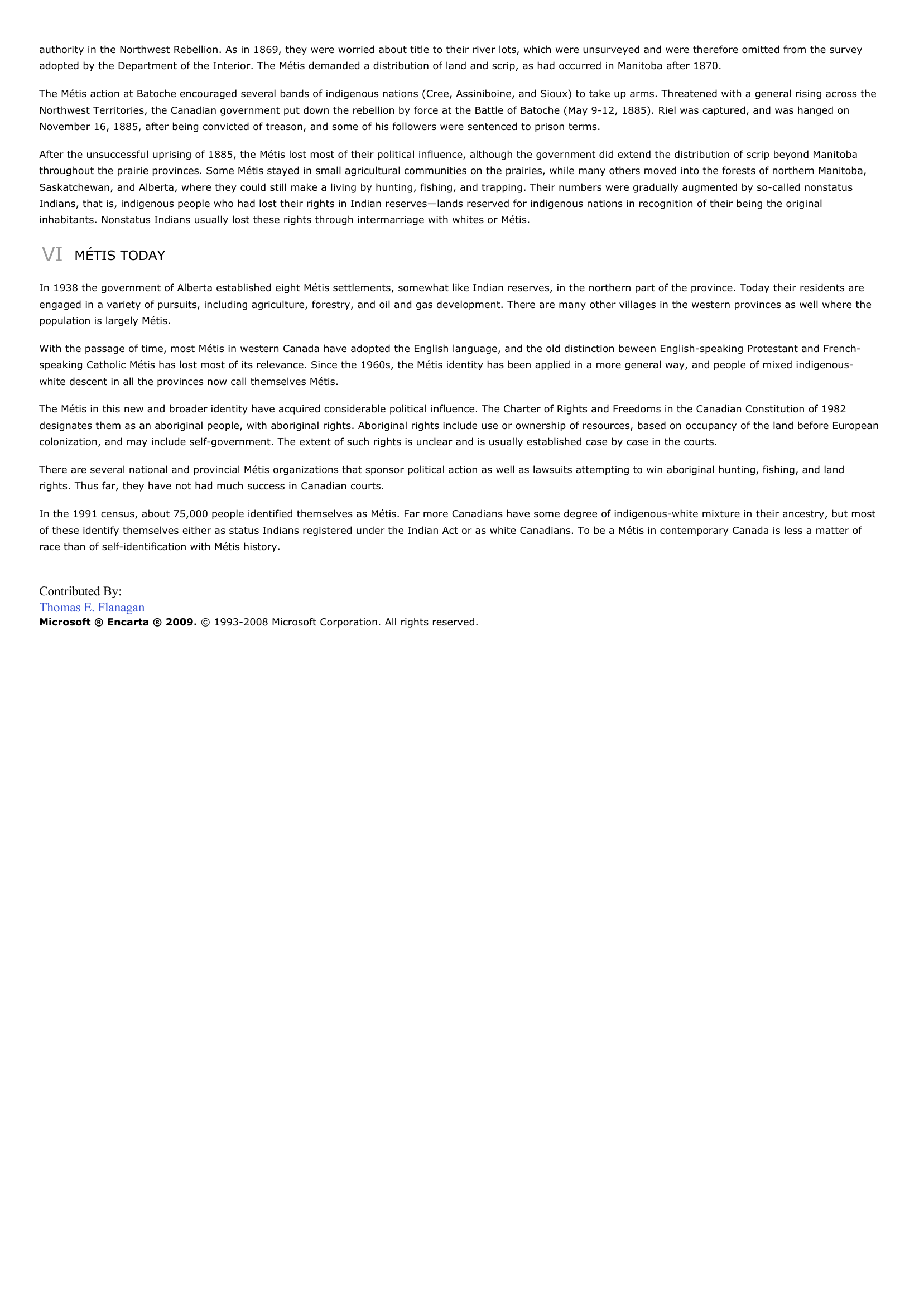Métis - Canadian History.
Publié le 03/05/2013

Extrait du document
«
authority in the Northwest Rebellion.
As in 1869, they were worried about title to their river lots, which were unsurveyed and were therefore omitted from the surveyadopted by the Department of the Interior.
The Métis demanded a distribution of land and scrip, as had occurred in Manitoba after 1870.
The Métis action at Batoche encouraged several bands of indigenous nations (Cree, Assiniboine, and Sioux) to take up arms.
Threatened with a general rising across theNorthwest Territories, the Canadian government put down the rebellion by force at the Battle of Batoche (May 9-12, 1885).
Riel was captured, and was hanged onNovember 16, 1885, after being convicted of treason, and some of his followers were sentenced to prison terms.
After the unsuccessful uprising of 1885, the Métis lost most of their political influence, although the government did extend the distribution of scrip beyond Manitobathroughout the prairie provinces.
Some Métis stayed in small agricultural communities on the prairies, while many others moved into the forests of northern Manitoba,Saskatchewan, and Alberta, where they could still make a living by hunting, fishing, and trapping.
Their numbers were gradually augmented by so-called nonstatusIndians, that is, indigenous people who had lost their rights in Indian reserves—lands reserved for indigenous nations in recognition of their being the originalinhabitants.
Nonstatus Indians usually lost these rights through intermarriage with whites or Métis.
VI MÉTIS TODAY
In 1938 the government of Alberta established eight Métis settlements, somewhat like Indian reserves, in the northern part of the province.
Today their residents areengaged in a variety of pursuits, including agriculture, forestry, and oil and gas development.
There are many other villages in the western provinces as well where thepopulation is largely Métis.
With the passage of time, most Métis in western Canada have adopted the English language, and the old distinction beween English-speaking Protestant and French-speaking Catholic Métis has lost most of its relevance.
Since the 1960s, the Métis identity has been applied in a more general way, and people of mixed indigenous-white descent in all the provinces now call themselves Métis.
The Métis in this new and broader identity have acquired considerable political influence.
The Charter of Rights and Freedoms in the Canadian Constitution of 1982designates them as an aboriginal people, with aboriginal rights.
Aboriginal rights include use or ownership of resources, based on occupancy of the land before Europeancolonization, and may include self-government.
The extent of such rights is unclear and is usually established case by case in the courts.
There are several national and provincial Métis organizations that sponsor political action as well as lawsuits attempting to win aboriginal hunting, fishing, and landrights.
Thus far, they have not had much success in Canadian courts.
In the 1991 census, about 75,000 people identified themselves as Métis.
Far more Canadians have some degree of indigenous-white mixture in their ancestry, but mostof these identify themselves either as status Indians registered under the Indian Act or as white Canadians.
To be a Métis in contemporary Canada is less a matter ofrace than of self-identification with Métis history.
Contributed By:Thomas E.
FlanaganMicrosoft ® Encarta ® 2009. © 1993-2008 Microsoft Corporation.
All rights reserved..
»
↓↓↓ APERÇU DU DOCUMENT ↓↓↓
Liens utiles
- Acadia - Canadian History.
- Alexander Mackenzie - Canadian History.
- Assembly of First Nations - Canadian History.
- Bertha Wilson - Canadian History.
- British North America Act - Canadian History.







